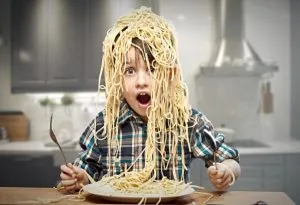When it comes to teaching something new to kids, always, always, lead by example. Constantly demonstrate and explain to your child what needs to be done and how. Children learn by observing and imitating their parents. So they need to see you and other family members setting the standards for good table manners like talking nicely at the table, using ‘please’ and ‘thank you’ while interacting with each other, etc.
Another way of teaching good table manners can be to organize dinner theme nights every week. You can choose a particular cuisine for example Chinese. Kids may not only find it a fun and interesting way to pick up good table manners like the use of chopsticks but may also learn about the culture and eating habits of different countries.
Toddlers
Toddlers may require persistent reminding to behave properly. It is important that parents start conditioning toddlers as early as they can start. Toddlers have a mind of their own, and for them, everything can be a game. So, you may have to keep repeating the rules again and again. It may be better to show them what they are expected to do. It may also help to demonstrate the consequences of not following the rules.
What You Can Teach
From the time your toddler starts eating solids, ensure that he sits and eats properly. Constantly reinforce the idea of sitting at the table each and every time they eat. You can let him leave the table once he is done eating.
- Try and involve your toddler during mealtimes by eating together as a family. This will give him the feeling that he is also a part of the family and mealtimes mean family time.
- You can help your toddler wash his hands before the family sits down to eat. He may get habituated to do so as he grows up.
- You can also try teaching your baby that throwing food, banging utensils, spitting food, screaming during mealtimes is unacceptable behavior.
What You Can Expect
Certain things that you can expect your toddler to do while eating include:
.Talking with a mouthful
- Reaching over to grab food from other’s plates
- Improper use of cutlery
Preschoolers
Preschoolers can be fussy and slow eaters and are prone to throwing tantrums. But a preschooler usually has more attention span than a toddler and can be better at following instructions. The best way to inculcate good table manners for kindergarteners can be by making them practice. It is important to explain to preschoolers what is expected of them at the table. Praise and encourage them when they behave well and cue them when they tend to slip. You may have to patiently remind them repeatedly.

Refrain from labelling a child when he tends to be sloppy or makes a mistake at the table. Instead, offer him a practical solution or advice. For example, if your child drops food on his clothes while eating, simply give him a napkin and explain its use to him.
What You Can Teach
You can teach preschoolers to:
- Properly sit at the table without squirming, wriggling or wandering around.
- To patiently wait till everyone is seated at the table and have helped themselves before start eating.
- The right way to use a napkin, how to place it on the lap before starting a meal, how to use it to wipe the mouth and so on.
- To take small bites and eat with his mouth closed and not to talk while he has a mouthful.
- To use polite words, like ‘please’ and ‘thank you’ while interacting with people at the table.
What You Can Expect
You can expect the following from your preschooler:
- He may make a mess while eating
- He may forget to follow the good manners while sitting at the table
Kids
Older kids are better equipped to understand the rules that they are expected to follow. They may realize how their actions can affect others and why manners are important. You can offer reasonable explanations to your child and tell him why he should adhere to the rules at the table and follow it up with rational consequences in case he refuses to observe them. For example, you can teach him that he won’t get a second helping of his favorite dessert unless he learns to ask politely or if his behavior is inappropriate at the table.
What You Can Teach
Older kids already know basic table manners. But there are certain things you can teach them. Such as:
- Proper use of the cutlery, how to use a fork and knife, the right choice of cutlery when faced with options like a smaller spoon for dessert, a soup spoon for soup, and so on.
- The art of making pleasant conversation at the table. Encourage him to compliment the food and teach him not to say something hurtful if he didn’t like the food.
- Laying the table with a proper placing of cutlery and clearing the table after the meals.
- How to properly serve and pass the food around the table without reaching over or being in someone’s face.
- Not to carry their tabs, cell phones or other gadgets to the table.
What You Can Expect
- Though kids at this stage are pretty clued in the lessons of good table manners, you can’t expect them to be perfect. Their can be times when your child may forget his manners or simply refuse to comply with the rules.
- Your child may encounter situations he may not be yet ready to tackle like a formal party or a fancy wedding reception with complicated tableware.
- You can’t expect the lessons in table etiquette for children to be over at this step. You may have to keep motivating your child to imbibe good table manners.
A family dinner must not be converted into some sort of a lecture or lesson on good table manners. Refrain from making mealtimes stressful for kids. Rather mealtimes should be family’s quality time together where family members can relax and share their day’s happenings and discuss other topics. Keep a balance between teaching kids good table manners and also making mealtimes fun and pleasurable for them.
SHIJINA RIJESH



